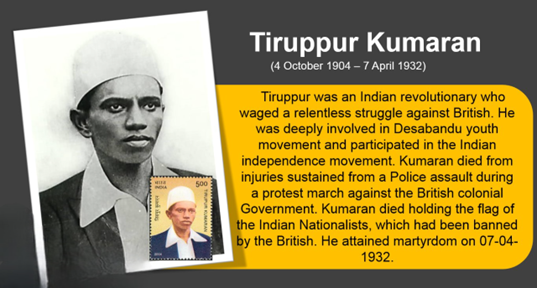PREVIOUS
Freedom Fighters from Tamil Nadu Part - 01
(இதன் தமிழ் வடிவத்திற்கு இங்கே சொடுக்கவும்)
1. Sivagami Ammaiyar
Early Life and Migration
- Sivagami Ammaiyar was born to Marimuthu Mudaliyar and Chinnathai in 1933 at Anna sagaram village in Dharmapuri district, Tamil Nadu.
- Her family migrated to Malaysia, where her father worked on a tea estate.
- She studied at Jai Hind Hindu Padasalai in Kuala Lumpur.
Inspiration and joining the INA
- Inspired by Netaji Subash Chandra Bose’s speech, Sivagami joined the Indian National Army (INA) in the ‘Balak Sena’ group for young boys and girls at the age of 11.
- She served as a caretaker and head of the social welfare hostel between 1942 and 1945.
Activism
- During her time in the INA, Sivagami performed a street play titled "Veera Vanitha" along with her brother Parantham, going from street to street to create a desire for freedom among people and to raise funds for the INA.
- Despite Netaji Subash Chandra Bose’s invitation to come to Burma, Sivagami refused.
Heroic Acts During WWII
- During the Second World War, Sivagami and her brother Paranthaman rescued people injured by bombs at Sarkar Camp.
Recognition and Awards
- In 1973, the Tamil Nadu government honoured Sivagami Ammaiyar with the "Tyaga Chemmal" Award.
- In 1993, she was honoured by Dr. J. Jayalalitha, the then Chief Minister of Tamil Nadu.
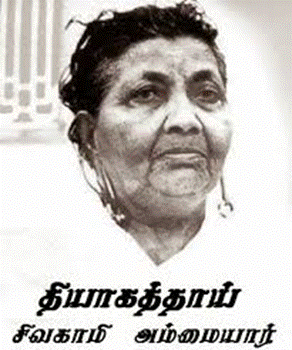
2. Maveeran Alagumuthu Kone
Early Life
- Maveeran Alagumuthu Kone was born on 11 July 1728 in Kattalankulam, Thoothukudi (Tuticorin) district, Tamil Nadu.
Role as a Polygar
- Alagumuthu Kone was an Indian polygar who rebelled against British occupation, becoming the country's first independence warrior.
- Between 1752 and 1759, he fought against the British soldiers in Tamil Nadu.
- He rose to the position of military commander in Ettayapuram and ruled over Kattalankulam.
Battles and Resistance
- In 1755, Alagumuthu, along with the force of Travancore, fought against Colonel Eran Keran’s army and emerged victorious.
- However, in 1759, he was defeated in battle against the British and Muruthanagayam’s forces.
Execution and Legacy
- Alagumuthu Kone was executed (Nadukaatur, Arcot) on 19 July 1759.
- In his memory, the government of Tamil Nadu conducts a Pooja ceremony every year on 11 July.
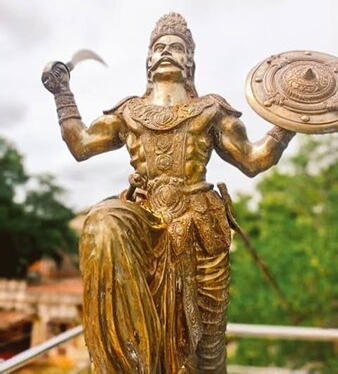
3. C. Subramaniyan
Early Life and Education
- C. Subramaniyan was born in a Brahmin family on 11 December 1882 in the village of Ettayapuram, Tamil Nadu, to Chinn swami Subramania Iyer and Lakshmi Ammal.
Exposure to Spirituality and Nationalism
- During his stay in Varanasi, he was exposed to Hindu spirituality and nationalism.
- This broadened his outlook, and he learned Sanskrit, Hindi, and English.
Involvement in Indian National Congress
- In December 1905, he attended the All-India Congress Session held in Banaras.
- He also attended the Indian National Congress Session in Calcutta under Dadabhai Naoroji, which demanded Swaraj and a boycott of British goods.
Exile and Revolutionary Activities
- Faced with the prospect of arrest, Subramaniyan escaped to Pondicherry, which was under French rule.
- During his exile, he had the opportunity to meet many other leaders of the revolutionary wing.
Social Reforms and Activism
- He fought for the emancipation of women, opposed child marriage, and advocated for reforms within Brahminism.
Death
- C. Subramaniyan died on 11 September 1921.
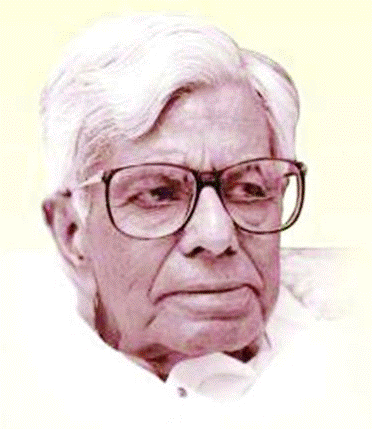
4. Kumaraswami Kamaraj
Early Life and Education
- Kumaraswami Kamaraj was born to Sivakami Ammal and Kumaraswami Nadar on July 15, 1903, in Virudhunagar, Tamil Nadu.
- His initial name was Kamatchi, which was eventually altered to Kamaraj.
- Kumaraswami Nadar was a merchant by profession.
- As a young boy, Kamaraj worked in his uncle's provision shop, where he developed an interest in prevailing political conditions by reading newspapers daily.
Influence of the Jallianwala Bagh Massacre
- The Jallianwala Bagh massacre was a decisive turning point in his life.
- Kamaraj decided to fight for national freedom and to bring an end to foreign rule.
Early Political Involvement
- In 1920, Kamaraj became active in politics and joined the Indian National Congress as a full-time political worker.
- He visited villages, carrying Congress propaganda, and met Mahatma Gandhi in September 1921.
Participation in Key Movements
- In 1922, Congress boycotted the visit of the Prince of Wales as part of the Non-Cooperation Movement.
- Kamaraj came to Madras to take part in the event.
- Between 1923 and 1925, he participated in the Nagpur Flag Satyagraha.
- He went to jail (Alipore) for two years in June 1930 for participating in the Salt Satyagraha.
- Kamaraj was arrested again in August 1942 (Vellore) in connection with the Quit India Movement.
- Over the course of his life, he was imprisoned six times by the British for his pro-independence activities.
Chief Minister of Madras State
- Kamaraj served as the Chief Minister of Madras State (now Tamil Nadu) from 1954 to 1963.
- His tenure is often considered a golden era for Tamil Nadu due to his focus on education, irrigation, and industrial development.
Educational Reforms
- Kamaraj implemented significant educational reforms, including the introduction of the mid-day meal scheme to combat hunger and encourage school attendance.
- He established numerous schools, especially in rural areas, to ensure that every child had access to education.
Agricultural and Industrial Development
- He prioritized agricultural development by constructing dams and irrigation projects, which transformed the agrarian landscape of Tamil Nadu.
- His industrial policies led to the establishment of several industries, providing employment and boosting the state's economy.
Special Titles and Honors
- Kamarajar was honored with several titles for his contributions to the Indian independence movement and his work in politics:
- Kingmaker: Due to his pivotal role in Indian politics, especially in the 1960s, where he played a crucial role in the selection of the Indian Prime Ministers.
- Kalvi Thanthai: He was hailed as Father of Education for his efforts to improve the education system of Tamil Nadu.
- Perun thalaivar: He was called Perun thalaivar for his remarkable leadership and contribution to society.
- Bharat Ratna: Posthumously awarded India's highest civilian honor in 1976 for his immense contributions to the country.
Kamaraj Plan
- In 1963, Kamaraj proposed the "Kamaraj Plan," a strategy to revitalize the Indian National Congress. He suggested that senior Congress leaders should resign from their ministerial posts to work to strengthen the party.
- Kamaraj himself resigned as Chief Minister to set an example.
- This plan led to the resignation of several senior leaders, including Lal Bahadur Shastri and Jagjivan Ram, to focus on party organization.
Later Life and Death
- After resigning as Chief Minister, Kamaraj continued to play a significant role in national politics. He served as the President of the Indian National Congress from 1964 to 1967.
- His influence was crucial during the succession of Prime Ministers after Jawaharlal Nehru's death.
- Kumaraswami Kamaraj passed away on October 2, 1975.
- His legacy continues to inspire generations, and he is remembered as one of India's most influential leaders.
Death
- Kumaraswami Kamaraj passed away on October 2, 1975.
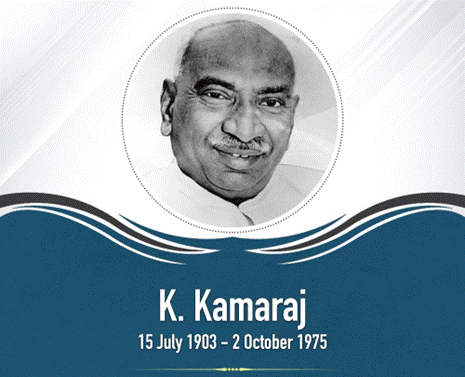
5. Subramaniya Siva
Early Life
- Subramaniya Siva was born into a Brahacharanam Iyer family in Vatlagundu, near Dindigul, in the Madurai district of the Madras presidency.
- He was the son of Rajam Iyer.
Involvement in the Independence Movement
- In 1908, Subramaniya Siva joined the Indian independence movement.
- He became the first political prisoner held at Madras jail when he was taken into custody by the British that same year.
Imprisonment and Health Struggles
- During his imprisonment, Siva was transferred to Salem jail while being treated for leprosy.
- After his release, the British government prevented him from traveling by rail due to the infectious nature of leprosy, forcing him to travel by foot.
- Despite these hardships, he persisted in his quest for independence and spent a considerable amount of time in jail until 1922.
Literary Contributions
- In addition to his political activities, Subramaniya Siva was a prolific writer.
- He authored the novels "Madhva Vijayam" and "Ramanuja Vijayam," and also published a periodical called "Gnanabhanu."
Death
- Subramaniya Siva lost his battle with leprosy on July 23, 1925 at Papparapatti in Dharmapuri.
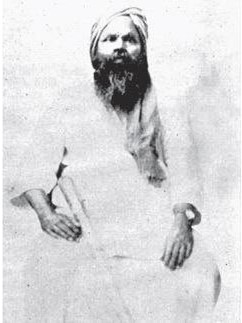
6. Tirupur Kumaran
Early Life
- Tirupur Kumaran, also known as Kodi Kaatha Kumaran, was born on 4 October 1904 in the Erode district of Tamil Nadu.
- His parents were Nachimuthu Mudaliyar and Karuppaayi.
Activism and Leadership
- Kumaran founded the Desa Bandhu Youth Association and led protests against the British colonial government.
Martyrdom
- On 11 January 1932, during a protest march against the British government on the banks of the Noyyal River in Tirupur, Kumaran died from injuries sustained from a police assault.
- At the time of his death, he was holding the flag of the Indian Nationalists, which had been banned by the British.
- This act of defiance earned him the epithet Kodi Kaatha Kumaran in Tamil, meaning “Kumaran who protected the flag.”
